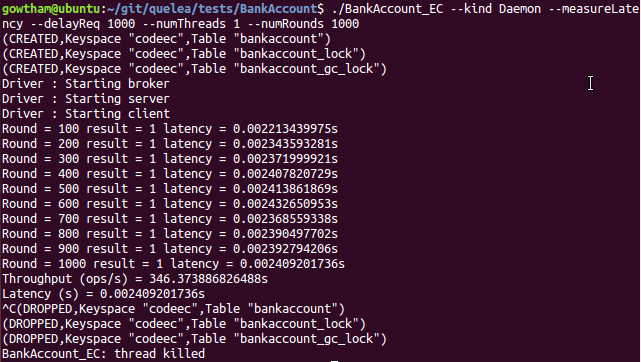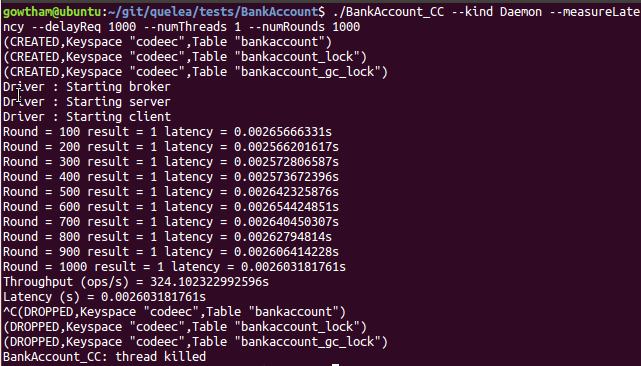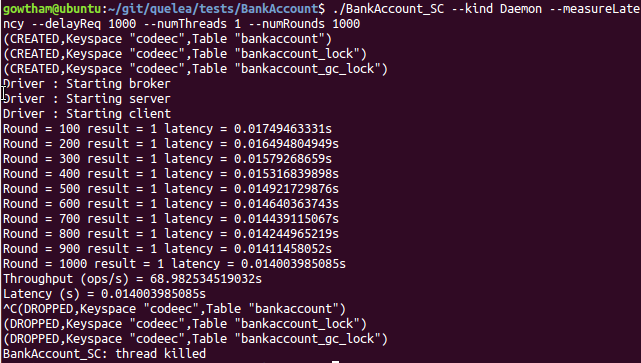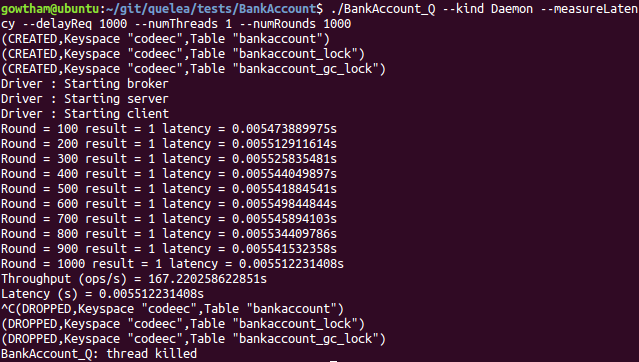This benchmark implements a simple replicated BankAccount data type
supporting three operations - Deposit, Withdraw and GetBalance.
Building the Benchmark
Navigate to ~/git/quelea/tests/BankAccount, and run make. On the
stdout, along with GHC’s build information, you should find something
similar to the following getting printed:

The above lines indicate the consistency class for each Bank Account
operation (i.e., ), along with
the time taken to classify the operation, and also the total time
consumed by the contract classification procedure. Similar information
is also displayed for Bank Account transactions (namely, saveTxn,
and totalBalanceTxn). Observe that compile-time overhead of
classifying each operation is very low, and the total overhead of
contract classification is roughly the sum of overheads incurred in
each case.
Succesfully building the benchmark results in four binaries -
BankAccount_EC, BankAccount_CC, BankAccount_SC, and
BankAccount_Q, that correspond to curves named EC, CC, SC and
Q in the graph shown in Fig. 9(a) of our
paper.
Running the Benchmark
First, we run a basic experiment to measure latency and throughput,
when a single client sends 1000 successive requests (with an
inter-request delay of 1ms (1000 μs)). We take the measurements for
each of the EC, CC, SC, and Q cases. Client requests are
roughly 25% getBalances, 25% deposits, and 50% withdraws. EC,
CC and SC binaries run all operations under eventual, causal and
strong consistency levels, respectively. On the other hand, the Q
testcase runs operations at appropriate consistency levels as
determined by the contract classification procedure. The commands to
execute, and output generated in our sample runs are shown below.
Please note that experiments can be terminated either manually (via
CTRL+C), or by setting a hard time limit via --terminateAfter
option, which accepts number of seconds as argument.
EC
./BankAccount_EC --kind Daemon --measureLatency --delayReq 1000 --numThreads 1 --numRounds 1000

Once you have aggregate latency and throughput data, terminate the
experiment by pressing CTRL-C. If you have encountered an error, or
if you suspect that execution is not making progress, please refer to
the troubleshooting guide
for quick fix.
CC
./BankAccount_CC --kind Daemon --measureLatency --delayReq 1000 --numThreads 1 --numRounds 1000

SC
./BankAccount_SC --kind Daemon --measureLatency --delayReq 1000 --numThreads 1 --numRounds 1000

Q
./BankAccount_Q --kind Daemon --measureLatency --delayReq 1000 --numThreads 1 --numRounds 1000

The experiment can now be repeated varying the number of client
threads (--numThreads) from 2 to 8. Screenshots capturing
measurements for sample runs when --numThreads is 4 are shown below:
EC

CC

SC

Q

Observations
As shown in the sample runs, you should be able to observe that:
- Throughput is highest when all operations are executed under
eventual consistency (EC). Causal consistency (CC) throughput is
comparable to that of EC. However, in both cases,
withdrawoperation can exhibit incorrect behaviour. - Throughput is lowest when all operations are executed under Strong Consistency (SC).
- Testcase
BankAccount_Q, which executes operations at appropriate consistency levels, delivers performance which is between the above two extremes.